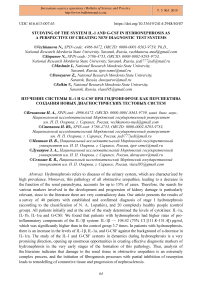Studying of the system IL-1 and G-CSF in hydronephrosis as a perspective of creating new diagnostic test systems
Автор: Vechkanova Natalia, Stepanov Nikita, Mashnin Igor, Duvayarov Z., Selkin V.
Журнал: Бюллетень науки и практики @bulletennauki
Рубрика: Медицинские науки
Статья в выпуске: 3 т.5, 2019 года.
Бесплатный доступ
Hydronephrosis refers to diseases of the urinary system, which are characterized by high prevalence. Moreover, this pathology of all obstructive uropathies, leading to a decrease in the function of the renal parenchyma, accounts for up to 15% of cases. Therefore, the search for various markers involved in the development and progression of kidney damage is particularly relevant, since in the literature there are very contradictory data. Our article presents the results of a survey of 40 patients with established and confirmed diagnosis of stage I hydronephrosis (according to the classification of N. A. Lopatkin), and 20 completely healthy people (control group). All patients initially and at the end of the study determined the levels of cytokines: IL-1a, IL-1b, IL-1ra and G-CSF. We found that patients with hydronephrosis had higher rates of pro-inflammatory components of the IL-1β system: IL-1β - 104.42 (75% CI [111.8-151.4]) pg/ml, which was significantly higher than in the control group 3.7 times...
Hydronephrosis, obstructive uropathy, il-1, g-csf
Короткий адрес: https://sciup.org/14115326
IDR: 14115326 | УДК: 616.613-007.63 | DOI: 10.33619/2414-2948/40/07
Список литературы Studying of the system IL-1 and G-CSF in hydronephrosis as a perspective of creating new diagnostic test systems
- Aron B., Tessler A., Morales P. Angiography in hydronephrosis // Urology. 1973. V. 2. №3. P. 231-236.
- Krajewski W. Wojciechowska J., Dembowski J., Zdrojowy R., Szydełko T. Hydronephrosis in the course of ureteropelvic junction obstruction: An underestimated problem? Current opinions on the pathogenesis, diagnosis and treatment // Advances in clinical and experimental medicine: official organ Wroclaw Medical University. 2017. V. 26. №5. P. 857-864.
- Carlström M. Hydronephrosis and risk of later development of hypertension // Acta Paediatrica. 2019. V. 108. №1. P. 50-57.
- Faure A., London K., Smith G. H. H. Early mercaptoacetyltriglycine (MAG-3) diuretic renography results after pyeloplasty // BJU international. 2016. V. 118. №5. P. 790-796.
- Fernbach S. K. Ultrasound grading of hydronephrosis: introduction to the system used by the Society for Fetal Urology // Pediatr Radiol. 2013. V. 23. №6. P. 478-480.
- Harber M. Hydronephrosis // Practical Nephrology. 2015. V. 114. №12. P. 901-915.
- Fernbach S. K., Maizels M., Conway J. J. Ultrasound grading of hydronephrosis: introduction to the system used by the Society for Fetal Urology // Pediatric radiology. 1993. V. 23. №6. P. 478-480.
- Rickard M., Lorenzo A. J., Braga L. H., Munoz C. Parenchyma-to-hydronephrosis area ratio is a promising outcome measure to quantify upper tract changes in infants with high-grade prenatal hydronephrosis // Urology. 2017. V. 104. P. 166-171.
- Taylor A. T. Radionuclides in nephrourology, part 1: radiopharmaceuticals, quality control, and quantitative indices // Journal of Nuclear Medicine. 2014. V. 55. №4. P. 608-615.
- Van Batavia J. P., Tasian G. E. Clinical effectiveness in the diagnosis and acute management of pediatric nephrolithiasis // International Journal of Surgery. 2016. V. 36. P. 698-704.
- Van Dervoort K., Lasky S., Sethna C., Frank R., Vento S., Choi-Rosen J., Trachtman H. Hydronephrosis in infants and children: natural history and risk factors for persistence in children followed by a medical service // Clin Med Pediatr. 2009. V. 3. P. 63-70.


